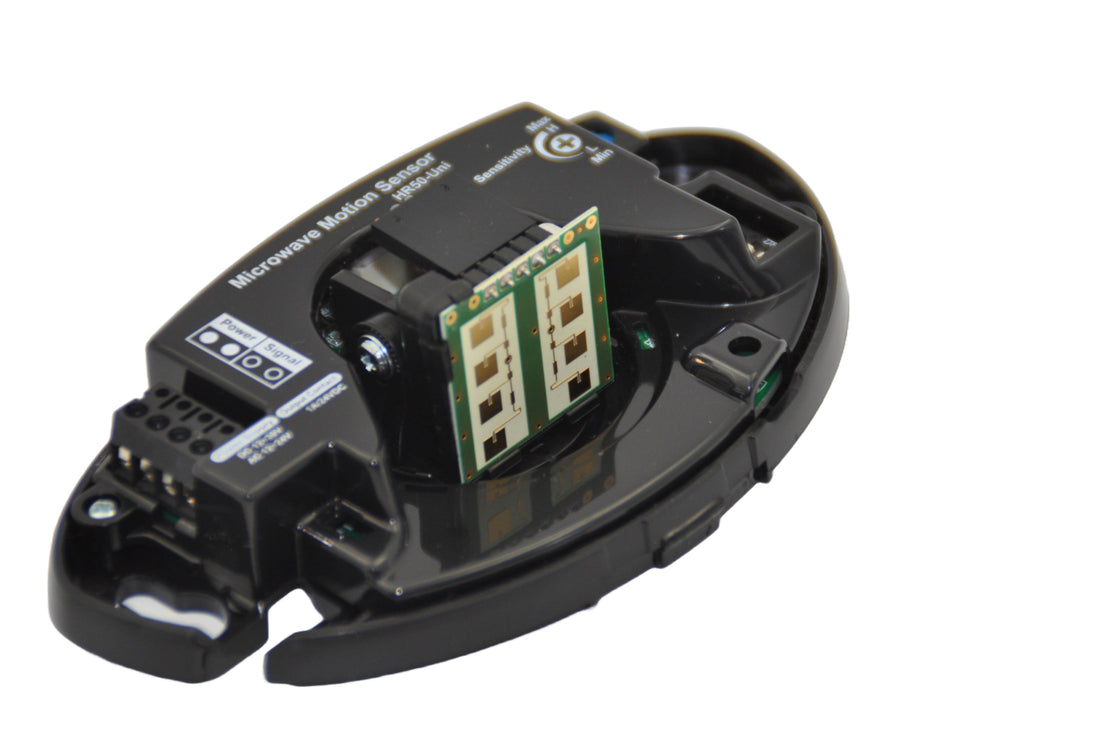
Understanding Automatic Door Sensors in the UK
Share
Automatic doors are integral to modern infrastructure, offering convenience, hygiene, and accessibility across various UK buildings—from retail spaces and hospitals to office buildings and transport hubs. Central to their operation are sophisticated sensors that detect movement, presence, or pressure, activating doors to open or close appropriately.
Types of Automatic Door Sensors
1. Motion Detection Sensors
Motion sensors activate doors upon detecting movement within a predefined range, typically from 1 to 3 meters. They primarily come in two forms:
-
Microwave Sensors: Emit high-frequency radio waves that reflect off moving objects, triggering door activation. Ideal for high-traffic entrances due to their broad detection range.
-
Passive Infrared (PIR) Sensors: Detect heat emitted by objects (particularly the human body) in the form of infrared radiation. When a warm object enters the sensor’s detection zone, typically between 1 and 2 meters, the sensor identifies a sudden change in infrared levels and sends a signal to open the door.
2. Presence Detection Sensors
Presence sensors maintain doors open when objects or people are detected within their immediate vicinity, ensuring safety and accessibility.
-
Active Infrared Sensors (Electro-sensitive protective equipment - ESPE): Emit infrared beams towards specific areas near the door. If the beam is interrupted or reflected differently, the sensor registers a presence, halting door closure to prevent injuries.
-
Ultrasonic Sensors: Send out high-frequency sound waves that reflect back upon encountering an object. The sensor calculates distance by measuring echo return times, prompting the door to remain open when changes are detected.
3. Pressure Sensors (Pressure-sensitive protective equipment - PSPE)
Detect weight using mats placed at the entrance of doors. When stepped on, these mats compress internal elements, generating a change in electrical resistance or creating an electrical signal, triggering the door to open.
4. On-Door Sensors for Swing Doors
Mounted directly on the door leaf, these sensors monitor the area immediately around the door, detecting anyone approaching or standing near to prevent collisions or accidents. They typically use active infrared technology to continuously monitor both sides of the door during opening and closing cycles.
5. Dual Sensors for Sliding Doors
Combine activation and safety functions into one unit, typically employing microwave technology for detecting movement and active infrared sensors for presence detection. This combination ensures immediate door opening upon approach and maintains door safety by detecting stationary persons or objects.
6. Access Control Systems
In secure environments, automatic doors may include access control features:
-
Keycards and Fobs: Users present a card or fob with a microchip or RFID tag to a reader. If the credentials match, the reader authorizes the door to unlock and open.
-
Biometric Scanners: Verify unique biological characteristics (fingerprints, facial recognition, iris scans). Upon positive identification, the control system activates the door.
-
Smartphone Apps: Communicate via wireless technology (Bluetooth, NFC, or Wi-Fi), prompting the door to unlock and open as an authorized user approaches.
Safety and Integration Considerations
Modern automatic doors often integrate multiple sensor types for maximum safety and efficiency. Combining motion and presence detection ensures doors open promptly and remain open until clear of obstructions. Standards such as BS EN 16005 specify that safety-related control systems must meet defined performance levels, ensuring robust safety standards. Additionally, comprehensive risk assessments and regular safety checks are essential to maintain these standards.
Motion Sensor Detection Distances
-
Microwave Sensors: Typically detect motion within a range of 1 to 3 meters, adjustable based on specific requirements.
-
PIR Sensors: Effective within 1 to 2 meters, suitable for controlled indoor environments.
-
Ultrasonic Sensors: Can detect presence within a range of up to 4 meters, depending on the model and installation.
Recommended Automatic Door Sensors
Here are some top-rated automatic door sensors suitable for various applications:
-
Hotron HR100-CT Activation and Safety Sensor: An infrared sensor ideal for sliding doors, offering adjustable detection areas to eliminate false door openings in busy environments.
-
Bea Eagle : A microwave motion sensor known for its reliability and wide detection range, suitable for high-traffic entrances.
-
Ixio-DT1V Dual Technology Activation & Safety Sensor: Combines microwave and infrared technologies, providing both activation and safety functions, ideal for sliding doors.
📝 Conclusion
Automatic door sensors significantly enhance convenience and safety across various UK sectors. Understanding how different sensor technologies function, supported by adherence to rigorous safety standards, ensures informed decisions, safer operation, and improved accessibility in public and commercial buildings.
